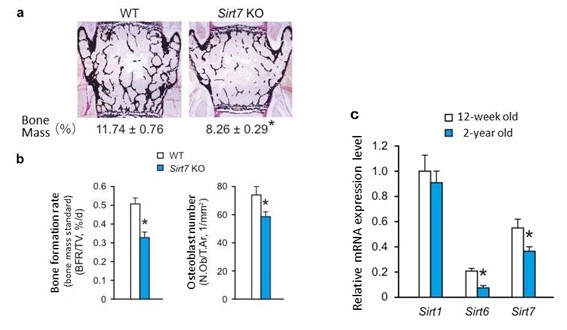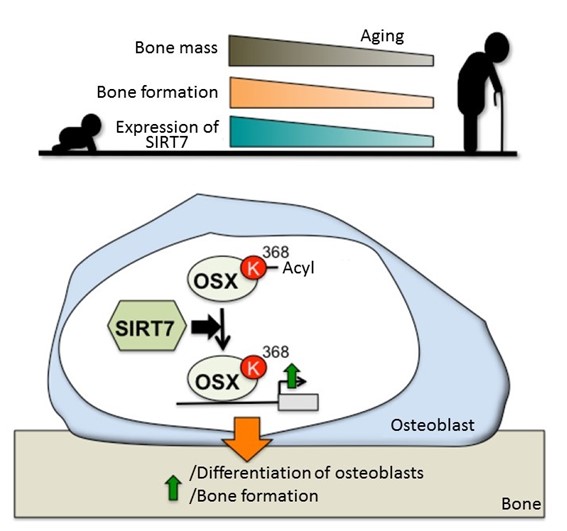Breaking osteoporosis: New mechanism activates bone-building cells On the road to developing new therapeutic drugs for osteoporosis and other bone degenerative diseases.
BACKGROUNDOsteoporosis is a disease that causes bones to fracture easily due to a reduction in both bone mass and quality. Aging is one of its leading causes, and it is estimated that around 200 million people are affected worldwide. Fractures of the femoral neck--the connection between the femur and the hip joint--or of vertebrae can leave a person bedridden which increases the need for care, reduces quality of life and systemic function, and increases mortality.
Bone is a living tissue that is repeatedly broken down (bone resorption) and remade (bone formation) little by little every day. If this balance collapses and bone resorption exceeds bone formation, bone density decreases and can lead to osteoporosis. Several medications are available to treat this disease, but the number of drugs that promote bone formation are far fewer compared to those that suppress bone resorption. The development of therapeutic agents that regenerate bones is highly desired.
Sirtuins are enzymes that play important roles in controlling aging, stress responses, various areas of the metabolism, and several other body functions. In mammals, there are seven types of sirtuins, SIRT1 to SIRT7. Although SIRT7 has been reported to be involved in cancer and lipid metabolism, its role in bone tissue and bone aging was unknown.
RESEARCH
1. The effect of SIRT7 on bone formation
Recent experiments performed by a research group led by scientists from Kumamoto University, Japan showed that mice lacking the SIRT7 gene had reduced bone mass. A bone morphometry analysis showed that bone formation and the number of osteoblasts (bone-building cells) had been reduced. Furthermore, the researchers obtained similar results using osteoblast-specific SIRT7 deficient mice, thereby showing that (osteoblast-specific) SIRT7 is important for bone formation.
2. Expression of sirtuins in bone tissue of old mice
Reduced bone formation is common in people with osteoporosis, and the mechanism for this reduction is not well known. To clarify the mechanism, the researchers compared sirtuin (SIRT1, 6, and 7) expression in the skeletal tissue of young and old mice, and found that SIRT7 decreased with age. They then considered that this decrease in SIRT7 in the older specimens may be associated with decreased osteogenesis, and may even be a cause of osteoporosis.
3. The effect of SIRT7 on osteoblast differentiation
When the researchers cultured osteoblasts (in vitro) with decreased SIRT7 expression in their next experiment, the formation of a bone-like mass (calcified nodule) was markedly suppressed compared to cultures of normal osteoblasts. Additionally, the expression of genes indicating osteoblast differentiation was also decreased, thereby revealing that SIRT7 controls the differentiation of osteoblasts.
4. Transcriptional activation of SP7/Osterix by SIRT7
To clarify the mechanism by which osteoblastic SIRT7 positively regulates the differentiation of osteoblasts, researchers investigated the transcription activity of the gene expression regulatory factor essential for osteoblast differentiation. They found that the transcription activity of SP7 (also known as Osterix), a protein known to induce differentiation of pre-osteoblasts into mature osteoblasts and osteocytes, was markedly decreased in osteoblasts that lacked the SIRT7 gene.
They also realized that to get high transcription activation of SP7/Osterix, it is important for SIRT7 to deacylate the 368th lysine residue of the SP7/Osterix protein. In other words, SIRT7 enhances the transcriptional activity of SP7/Osterix by chemically modifying it (deacylating the 368th lysine residue). Furthermore, the researchers were able to recover osteoblast functionality in the calcified nodule formation by introducing a mutant SP7/Osterix, which deacylated the 368th lysine of SP7/Osterix, into the osteoblasts that had reduced SIRT7 expression.
The research group is confident that their results show a new mechanism for SIRT7 as a deacylating enzyme important for transcriptional activation of the gene expression regulator SP7/Osterix and is essential for osteoblast differentiation.
"In situations where SIRT7 does not work sufficiently, such as in an older individual, osteoblast formation is impaired due to low SP7/Osterix transcriptional activity. We believe that this decreased osteogenesis is associated with osteoporosis," said study leader Dr. Tatsuya Yoshizawa of Kumamoto University. "Our results, show that the regulatory pathway of SIRT7 - SP7 / Osterix is a promising target for new therapeutic agents to treat decreased osteogenesis and osteoporosis."
This research was published online in "Nature Communications" on 19 July 2018.
*The results of this research are based on collaborative research between Kumamoto University, Tsurumi University, Tokyo Medical and Dental University (Japan), and the Max Planck Institute (Germany).
[Source]
Fukuda, M., Yoshizawa, T., Karim, M. F., Sobuz, S. U., Korogi, W., Kobayasi, D., … Yamagata, K. (2018). SIRT7 has a critical role in bone formation by regulating lysine acylation of SP7/Osterix. Nature Communications, 9(1). doi:10.1038/s41467-018-05187-4
[Paper Info]
TITLE:
SIRT7 has a critical role in bone formation by regulating lysine acylation of SP7/Osterix
AUTHORS:
Masatoshi Fukuda*, Tatsuya Yoshizawa*, Md. Fazlul Karim*, Shihab U. Sobuz, Wataru Korogi, Daiki Kobayasi, Hiroki Okanishi, Masayoshi Tasaki, Katsuhiko Ono, Tomohiro Sawa, Yoshifumi Sato, Mami Chirifu, Takeshi Masuda, Teruya Nakamura, Hironori Tanoue, Kazuhisa Nakashima, Yoshihiro Kobashigawa, Hiroshi Morioka, Eva Bober, Sumio Ohtsuki, Yuriko Yamagata, Yukio Ando, Yuichi Oike, Norie Araki, Shu Takeda, Hiroshi Mizuta, and Kazuya Yamagata
*corresponding author
JOURNAL:
Nature Communications
9, Article number: 2833 (2018)
DOI:
10.1038/s41467-018-05187-4
URL:
https://www.nature.com/articles/s41467-018-05187-4
[Fund]
(1) MEXT - Grant-in-Aid for Scientific Research (KAKENHI (B)), (2) KAKENHI C, (3) Scientific Research on Innovative Areas “Stem Cell Aging and Disease”, (4) Japan Agency for Medical Research and Development (AMED), (5) The Takeda Science Foundation, (6) The Japan Endocrine Society, (7) The Naito Foundation, (8) The Uehara Memorial Foundation, (9) The Astellas Foundation for Research on Metabolic Disorders
<NUMBERS>
(1) 16H05328, (2) 17K11014, (3) 17H05650, (4) JP17gm5010002,
(5) NA, (6) NA, (7) NA, (8) NA, (9) NA
[Image1]

Bone tissue formation rates and expression of sirtuin in bone tissue of old mice
CAPTION:
(a) Mouse vertebral tissue: The amount of bone (dyed in black) is reduced in Sirt7 knockout (KO) mice compared to wild type (WT) mice. (b) The bone formation rate and number of osteoblasts decreased in Sirt7 KO mice compared to WT mice. (c) Expression of nucleic sirtuin in bone tissue of old (2-yr old) mice is less than in young (12-wk old) mice. (Student’s t-test: *p < 0.05 vs. WT mice)
Adapted from Fig. 2 of Fukuda, M., Yoshizawa, T., Karim, M. F., Sobuz, S. U., Korogi, W., Kobayasi, D., … Yamagata, K. (2018). SIRT7 has a critical role in bone formation by regulating lysine acylation of SP7/Osterix. Nature Communications, 9(1). doi: 10.1038/s41467-018-05187-4.
[Image 1 & 2 Details]
CREDIT: Dr. Tatsuya Yoshizawa
USAGE RESTRICTIONS: This image is available under the terms of the Creative Commons Attribution 4.0 License. Any further distribution of this work must maintain attribution to the author(s) and the title of the article, journal citation, and DOI.
[Image2]

The effect of SIRT7 on osteoblast differentiation
Caption:
Osteoblasts with reduced expression of SIRT7 show markedly reduced calcification (stained red) compared to normal osteoblasts. Introduction of a mutant SP7/Osterix, which deacylated the 368th lysine of SP7/Osterix, into the osteoblasts that had reduced SIRT7 expression restores most of the calcification.
Adapted from Fig. 6 of Fukuda, M., Yoshizawa, T., Karim, M. F., Sobuz, S. U., Korogi, W., Kobayasi, D., … Yamagata, K. (2018). SIRT7 has a critical role in bone formation by regulating lysine acylation of SP7/Osterix. Nature Communications, 9(1). doi: 10.1038/s41467-018-05187-4.
[Image3]

The mechanism of bone formation control by SIRT7
Caption:
When SIRT7 does not work sufficiently, as happens during aging, osteoblasts have difficulty producing bone due to low transcriptional activity of SP7/Osterix, which is thought to cause decreased osteogenesis associated with osteoporosis.
[Image 3 Details]
CREDIT: Dr. Tatsuya Yoshizawa
USAGE RESTRICTIONS: This image may only be used in conjunction with the accompanying release, or stories written about the work described in the release with reference to the original work.
